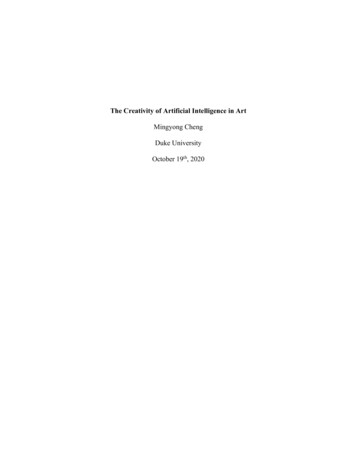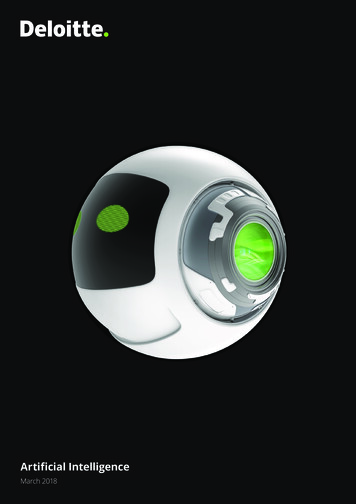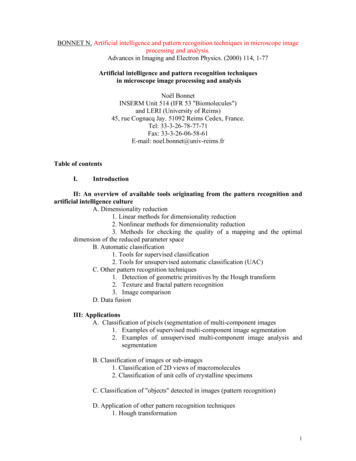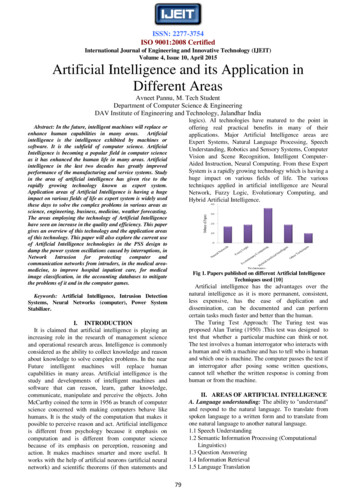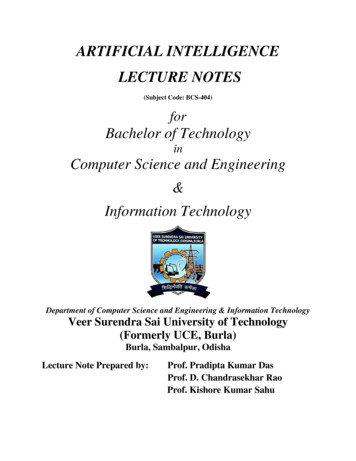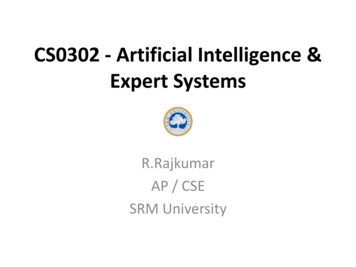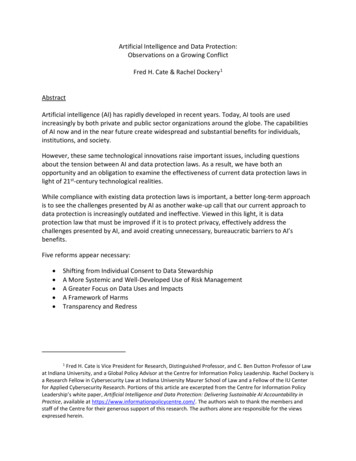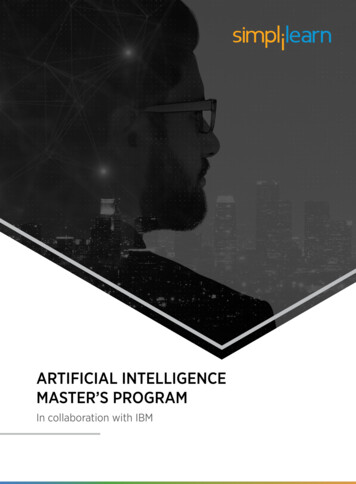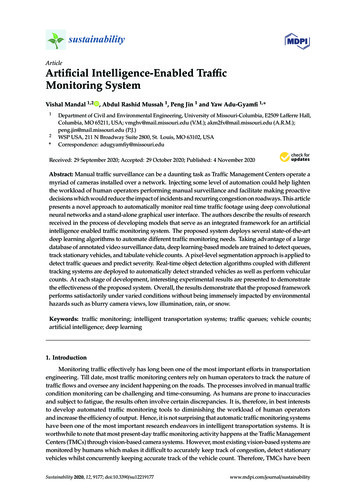
Transcription
sustainabilityArticleArtificial Intelligence-Enabled TrafficMonitoring SystemVishal Mandal 1,2 , Abdul Rashid Mussah 1 , Peng Jin 1 and Yaw Adu-Gyamfi 1, *12*Department of Civil and Environmental Engineering, University of Missouri-Columbia, E2509 Lafferre Hall,Columbia, MO 65211, USA; vmghv@mail.missouri.edu (V.M.); akm2fx@mail.missouri.edu (A.R.M.);peng.jin@mail.missouri.edu (P.J.)WSP USA, 211 N Broadway Suite 2800, St. Louis, MO 63102, USACorrespondence: adugyamfiy@missouri.eduReceived: 29 September 2020; Accepted: 29 October 2020; Published: 4 November 2020 Abstract: Manual traffic surveillance can be a daunting task as Traffic Management Centers operate amyriad of cameras installed over a network. Injecting some level of automation could help lightenthe workload of human operators performing manual surveillance and facilitate making proactivedecisions which would reduce the impact of incidents and recurring congestion on roadways. This articlepresents a novel approach to automatically monitor real time traffic footage using deep convolutionalneural networks and a stand-alone graphical user interface. The authors describe the results of researchreceived in the process of developing models that serve as an integrated framework for an artificialintelligence enabled traffic monitoring system. The proposed system deploys several state-of-the-artdeep learning algorithms to automate different traffic monitoring needs. Taking advantage of a largedatabase of annotated video surveillance data, deep learning-based models are trained to detect queues,track stationary vehicles, and tabulate vehicle counts. A pixel-level segmentation approach is applied todetect traffic queues and predict severity. Real-time object detection algorithms coupled with differenttracking systems are deployed to automatically detect stranded vehicles as well as perform vehicularcounts. At each stage of development, interesting experimental results are presented to demonstratethe effectiveness of the proposed system. Overall, the results demonstrate that the proposed frameworkperforms satisfactorily under varied conditions without being immensely impacted by environmentalhazards such as blurry camera views, low illumination, rain, or snow.Keywords: traffic monitoring; intelligent transportation systems; traffic queues; vehicle counts;artificial intelligence; deep learning1. IntroductionMonitoring traffic effectively has long been one of the most important efforts in transportationengineering. Till date, most traffic monitoring centers rely on human operators to track the nature oftraffic flows and oversee any incident happening on the roads. The processes involved in manual trafficcondition monitoring can be challenging and time-consuming. As humans are prone to inaccuraciesand subject to fatigue, the results often involve certain discrepancies. It is, therefore, in best intereststo develop automated traffic monitoring tools to diminishing the workload of human operatorsand increase the efficiency of output. Hence, it is not surprising that automatic traffic monitoring systemshave been one of the most important research endeavors in intelligent transportation systems. It isworthwhile to note that most present-day traffic monitoring activity happens at the Traffic ManagementCenters (TMCs) through vision-based camera systems. However, most existing vision-based systems aremonitored by humans which makes it difficult to accurately keep track of congestion, detect stationaryvehicles whilst concurrently keeping accurate track of the vehicle count. Therefore, TMCs have beenSustainability 2020, 12, 9177; ability
Sustainability 2020, 12, 91772 of 21laying efforts on bringing in some levels of automation in traffic management. Automated ability2020, 12, usingx FOR PEERREVIEWIntelligence (AI) have the capability to not only manage2 of 21well but also monitor and access current situations that can reduce the number of road accidents.keepantrackof congestion,detectwhilstandconcurrentlykeepingtrack of theSimilarly,AI-enabledsystemcanstationaryidentify vehicleseach vehicleadditionallytrackaccurateits movementpatternvehicle count. Therefore, TMCs have been laying efforts on bringing in some levels of automation incharacteristic to identify any dangerous driving behavior, such as erratic lane changing behavior.traffic management. Automated traffic surveillance systems using Artificial Intelligence (AI) have theAnother important aspect of an AI-enabled traffic monitoring system is to correctly detect any stationarycapability to not only manage traffic well but also monitor and access current situations that canvehicleson theOftentimes,there arestationaryvehicles whichbehindandthat impedesreducethe road.numberof road accidents.Similarly,an e flowof precedingand causesto stackThisanyresultsin congestionthat hampersadditionallytrackvehiclesits movementpatternvehiclescharacteristicto up.identifydangerousdriving behavior,the eAI-enabledthus an integralcomponent ofsuchas erraticchangingbehavior.trafficAnotherimportant systemsaspect of antraffic monitoringsystemis totocorrectlyon theroad. Oftentimes,are ationaryalleviatevehiclesthe effectsof trafficcongestion thereand destheflowofprecedingvehiclesandcausesvehiclesIn the last few years, there has been extensive research on machine and deep learning-basedstack up. Thisresults incongestionthat hampersfree .Certainactivitiessuch asthevehiclecount, ofandtrafficIntelligentdensity entofsystemsneededtoquicklydetectandalleviateare limited by the process of engaging human operators and requires some artificial intelligencethe effects of traffic congestion and human factors.intervention. Traffic count studies for example require human operators to be out in the field duringIn the last few years, there has been extensive research on machine and deep learning-basedspecific hours, or in the case of using video data, human operators are required to watch man hours oftraffic monitoring systems. Certain activities such as vehicle count, and traffic density estimation arepre-recordedfootageto get anof volumebe bothcumbersomelimited bythe processof accurateengaging estimationhuman operatorsand counts.requires Thissomecanartificialintelligenceand cvideosfrommultipleCCTVcameras,intervention. Traffic count studies for example require human operators to be out in the field duringit tioninrealtime.Therefore,mostTMCsspecific hours, or in the case of using video data, human operators are required to watch man hours seekof pre-recordedfootageto get anthataccurateestimationof volumecounts. Thisbe bothcumbersomeout deployingautomatedsystemscan, infact, alleviatethe workloadofcanhumanoperatorsand leadand time-consuming.Similarly,whenAtit comesto seeingvideos frommultipleCCTV cameras,to effectivetraffic managementsystem.the sametime, trafficthe associatedcostsare MCsdue to savings associated with not needing to store multiple hours of large video data. In this study,seek out severaldeployingautomated systemscan, infact, alleviatethe onworkloadof humanoperatorswe deployedstate-of-the-artdeep thatlearningalgorithmsbasedthe natureof certainrequiredand lead to effective traffic management system. At the same time, the associated costs aretraffic operations. Traditional algorithms [1–3] often record lower accuracies and fail at capturingcomparatively lower due to savings associated with not needing to store multiple hours of large videocomplex patterns in a traffic scene; hence, we tested and deployed deep learning-based models traineddata. In this study, we deployed several state-of-the-art deep learning algorithms based on the natureon thousandsannotatedtrafficimages.TraditionalThus, thealgorithmsproposed [1–3]systemas shownin Figure1 can performof certainofrequiredtrafficoperations.oftenrecord loweraccuraciesandthe following:fail at capturing complex patterns in a traffic scene; hence, we tested and deployed deep learning1.2.3.4.5.based models trained on thousands of annotated traffic images. Thus, the proposed system as shownMonitoring traffic congestionin Figure 1 can perform the following:Traffic accidents, stationary or stranded vehicle detection1. t2.Trafficaccidents,stationaryor strandedvehicle UserdetectionManaging traffic using a stand-aloneGraphicalInterface (GUI)3. Vehicle detection and countScaling traffic monitoring to multiple traffic cameras.4.5.Managing traffic using a stand-alone Graphical User Interface (GUI)Scaling traffic monitoring to multiple traffic cameras.1. Proposed front-end GUI-based system with algorithms and traffic database processed in theFigureFigure1. Proposedfront-end GUI-based system with algorithms and traffic database processedback end. To visualize the demonstration of the proposed GUI based platform, refer to [4].in the back end. To visualize the demonstration of the proposed GUI based platform, refer to [4].
Sustainability 2020, 12, 91773 of 212. Literature ReviewIn the past few years, several vision-based systems have been studied to automatically monitortraffic. We broadly discuss some of the related articles focused on congestion prediction, traffic countand anomaly detection.2.1. Deep Learning Frameworks for Object Detection and ClassificationThere are two main ways through which video-based congestion monitoring systemsfunction. The first instance is the method based on “three-step inference” and the other one isthe “one-step-classification” approach. Willis et al. in [5] studied traffic queues classification using deepneural networks on traffic images. The researchers trained a two-phase network using GoogLeNet and abespoke deep subnet, and applied that in the process of detecting traffic network congestion. Chakrabortyet al. in [6] used traffic imagery and applied both deep convolutional neural networks (DCNN) and YouOnly Look Once (YOLO) algorithms in different environmental set-ups. Similarly, for inference-basedapproaches, Morris et al. proposed a portable system for extracting traffic queue parameters at signalizedintersections from video feeds [7]. For that, they applied image processing techniques such as clustering,background subtraction, and segmentation, to identify vehicles and finally tabulated queue lengthsfor calibrated cameras at different intersections. Fouladgar et al. in [8] proposed a decentralized deeplearning-built system, wherein every node precisely predicted each of its congestion states based ontheir adjacent stations in real-time conditions. Their approach was scalable and could be completelydecentralized to predict the nature of traffic flows. Likewise, Ma et al. in [9] proposed an entirelyautomated deep neural network-based model for analyzing spatiotemporal traffic data. Their modelfirst uses convolutional neural network to learn the spatio-temporal features. Later, a recurrent neuralnetwork is trained by utilizing the output of their first-step model that helps categorize the completesequence. The model could be feasibly applied at studying traffic flows and predicting congestion.Similarly, Wang et al. in [10] introduced a deep learning model that uses an RCNN structure tocontinuously predict traffic speeds. Using their model and integrating the spatio-temporal trafficinformation, they could identify the sources of congestion on city ring-roads. Carli et al. in [11]proposed an automatic traffic congestion analysis in urban streets. They used GPS-generated data togeneralize traffic characteristics. Likewise, in this paper, the authors have demonstrated the usage of avideo-based congestion monitoring system which might not be as accurate as the GPS-based techniquebut are sturdy and yield lower operating costs. Furthermore, as congestion occurs frequently on urbanroadways, identifying different indicators for effectively planning transportation systems would bebeneficial [12].Popular object detection frameworks such as Mask R-CNN [13], YOLO [14], Faster R-CNN [15],etc. have been utilized far and beyond in the field of intelligent transportation systems (ITS). However,another state-of-the-art object detector called CenterNet [16] has not had enough exposure in ITS.So far, object detection using CenterNet has been successfully applied in the fields of robotics [17,18],medicine [19–21], phonemes [22], etc. Its faster inference speed and shorter training time have made itpopular for real-time object detection [23]. In this study, the authors deploy several state-of-the-artobject detectors including CenterNet. The use of CenterNet in the of context of ITS for studyingcounting problems, as applied in this study, is a novel idea worth looking into, which could also furtherserve as literature for future studies in this area.2.2. Vision-Based Traffic Analysis SystemsMost existing counting methods could be generally categorized as detection instance counter [24,25]or density estimator [25,26]. Detection instance counters localize every car exclusively and then countthe localization. However, this could hold a problem since the process requires scrutinizing the wholeimage pixel by pixel to generate localization. Similarly, occlusions could create another obstacle asdetectors might merge overlapping objects. In contrast, density estimators work in an instinctive
Sustainability 2020, 12, 91774 of 21manner of trying to create an approximation of density for countable vehicles and then assimilatingthem over that dense area. Density estimators usually do not require large quantities of training datasamples, but are generally constrained in application to the same scene where the training data arecollected. Chiu et al. in [27] presented an automatic traffic monitoring system that implements an objectsegmentation algorithm capable of vehicle recognition, tracking and detection from traffic imagery.Their approach separated mobile vehicles from stationary ones using a moving object segmentationtechnique that uses geometric features of vehicles to classify vehicle type. Likewise, Zhuang et al.in [28] proposed a statistical method that performs a correlation-based estimation to count city vehiclesusing traffic cameras. For this, they introduced two techniques, the first one using a statistical machinelearning approach that is based on Gaussian models, and the second one using the analytical deviationapproach based on the origin–destination matrix pair. Mundhenk et al. in [29] created a datasetof overhead cars and deployed a deep neural network to classify, detect and count the number ofcars. To detect and classify vehicles, they used a neural network called ResCeption. This networkintegrates residual learning with Inception-style layers that can detect and count the number of cars in asingle look. Their approach is superior in getting accurate vehicle counts in comparison to the countsperformed with localization or density estimation.Apart from congestion detection and vehicle counts, various articles have been reviewed to studyanomaly detection systems. Kamijo et al. in [30] developed a vehicle tracking algorithm based onspatio-temporal Markov random fields to detect traffic accidents at intersections. The model presentedin their study was capable of robustly tracking individual vehicles without their accuracies being greatlyaffected by occlusion and clutter effects, two very common characteristics at most busy intersectionswhich pose a problem for most models. Although traditionally, spot sensors were used primarily forincident detection [31], the scope of their use proved to be rather trivial for anomaly detection systems.Vision-based approaches have therefore been utilized far and beyond mostly due to their superiorevent recognition capability. Information such as traffic jams, traffic violations, accidents, etc. couldbe easily extracted from vision-based systems. Rojas et al. in [32] and Zeng et al. in [33] proposedtechniques to detect vehicles on a highway using a static CCTV camera, while, Ai et al. in [34] proposeda method to detect traffic violation at intersections. The latter’s approach was put into practice onthe streets of Hong Kong to detect red light runners. Thajchayapong et al. proposed an anomalydetection algorithm that could be implemented in a distributed fashion to predict and classify trafficabnormalities in different traffic scenes [35]. Similarly, Ikeda et al. in [36] used image-processingtechniques to automatically detect abnormal traffic incidents. Their method could detect four differenttypes of traffic anomalies such as detecting stopped vehicles, slow-speed vehicles, dropped objectsand the vehicles that endeavored to change lanes consecutively.3. Proposed MethodologyThe methodology adopted for implementing an automatic traffic monitoring system is shownin Figure 2. The main components consist of, first, a GPU-enabled backend (on premise) which isdesigned to ensure that very deep models can be trained quickly and implemented on a wide arrayof cameras in near real time. At the heart of the proposed AI-enabled traffic monitoring system isthe development and training of several deep convolutional neural network models that are capableof detecting and classifying different objects or segmenting a traffic scene into its constituent objects.Manually annotated traffic images served as the main source of dataset used for training these models.To enable the system to be situationally aware, different object tracking algorithms are implemented togenerate trajectories for each detected object on the traffic scene at all times. The preceding steps arethen combined to extract different traffic flow variables (e.g., traffic volume and occupancy) and monitordifferent traffic conditions such as queueing, crashes and other traffic scene anomalies. The AI-enabledtraffic monitoring system is capable of tracking different classes of vehicles, tabulating their count,spotting and detecting congestion and tracking stationary vehicles in real time.
Sustainability 2020, 12, 9177Sustainability 2020, 12, x FOR PEER REVIEW5 of 215 of tudyareare explainedexplained inin detaildetail asas follows:follows:Some3.1. Faster R-CNN3.1. Faster R-CNNFaster R-CNN is a two-stage target detection algorithm [15]. In Faster-RCNN, a Region ProposalFaster R-CNN is a two-stage target detection algorithm [15]. In Faster-RCNN, a Region ProposalNetwork (RPN) shares complete-image convolutional features along with a detection network thatNetwork (RPN) shares complete-image convolutional features along with a detection network thatenables cost-free region proposals. Here, the RPN simultaneously predicts object bounds and theirenables cost-free region proposals. Here, the RPN simultaneously predicts object bounds and theirequivalent score values at each position. End-to-end training of RPN provides high-class regionequivalent score values at each position. End-to-end training of RPN provides high-class regionproposals which is used by Faster R-CNN to achieve object predictions. Compared to Fast R-CNN,proposals which is used by Faster R-CNN to achieve object predictions. Compared to Fast R-CNN,Faster R-CNN produces high-quality object detection by substituting selective search method withFaster R-CNN produces high-quality object detection by substituting selective search method withRPN. The algorithm splits every image into multiple sections of compact areas and then passes everyRPN. The algorithm splits every image into multiple sections of compact areas and then passes everyarea over an arrangement of convolutional filters to extract high-quality feature descriptors which isarea over an arrangement of convolutional filters to extract high-quality feature descriptors which isthen passed through a classifier. After that, the classifier produces the probability of objects in eachthen passed through a classifier. After that, the classifier produces the probability of objects in eachsection of an image. To achieve higher prediction accuracies on traffic camera feeds, the model issection of an image. To achieve higher prediction accuracies on traffic camera feeds, the model istrained for five classes viz. pedestrian, cyclist, bus, truck and car. Training took approximately 8 h ontrained for five classes viz. pedestrian, cyclist, bus, truck and car. Training took approximately 8 h onNVIDIA GTX 1080Ti GPU. The model processed video feeds at 5 frames per second.NVIDIA GTX 1080Ti GPU. The model processed video feeds at 5 frames per second.3.2. Mask R-CNN3.2. Mask R-CNNMask R-CNN, abbreviated from Mask-region based Convolutional Neural Network, is an extensionMask R-CNN, abbreviated from Mask-region based Convolutional Neural Network, is anto Faster R-CNN [13]. In addition to accomplishing tasks equivalent to Faster R-CNN, Mask R-CNNextension to Faster R-CNN [13]. In addition to accomplishing tasks equivalent to Faster R-CNN, Masksupplements it by adding superior masks, and sections the region of interest pixel-by-pixel. The modelR-CNN supplements it by adding superior masks, and sections the region of interest pixel-by-pixel.used in this study is based on Feature Pyramid Network (FPN) and is executed with resnet101 backbone.The model used in this study is based on Feature Pyramid Network (FPN) and is executed withIn this, ResNet101 served as the feature extractor for the model. While using FPN, there was anresnet101 backbone. In this, ResNet101 served as the feature extractor for the model. While usingimprovement in the standard feature extraction pyramid by the introduction of another pyramid thatFPN, there was an improvement in the standard feature extraction pyramid by the introduction oftook higher level features from the first pyramid and consequently passed them over to subordinateanother pyramid that took higher level features from the first pyramid and consequently passed themlayers. This enabled features at each level to obtain admission at both higher and lower-level characters.over to subordinate layers. This enabled features at each level to obtain admission at both higher andIn this study, the minimum detection confidence rate was set at 90% and run at 50 validation steps.lower-level characters. In this study, the minimum detection confidence rate was set at 90% and runAn image-centric training approach was followed in which every image was cut to the square’s shape.at 50 validation steps. An image-centric training approach was followed in which every image wasThe images were converted from 1024 1024px 3 (RGB) to a feature map of shape 32 32cut to the square’s shape. 2048 on passing through the backbone network. Each of our batch had a single image per GPUThe images were converted from 1024 1024px 3 (RGB) to a feature map of shape 32 32 and every image had altogether 200 trained Region of Interests (ROIs). Using a learning rate of 0.0012048 on passing through the backbone network. Each of our batch had a single image per GPU andand a batch size of 1, the model was trained on NVIDIA GTX 1080Ti GPU. A constant learning rateevery image had altogether 200 trained Region of Interests (ROIs). Using a learning rate of 0.001 andwas used during the iteration. Likewise, a weight decay of 0.0001 and a learning momentum of 0.9a batch size of 1, the model was trained on NVIDIA GTX 1080Ti GPU. A constant learning rate wasused during the iteration. Likewise, a weight decay of 0.0001 and a learning momentum of 0.9 were
Sustainability 2020, 12, 9177Sustainability 2020, 12, x FOR PEER REVIEW6 of 216 of 21used.used.The totaltime forthetrainingon a sampledatasetwas approximately3 h. ThewereThe trainingtotal trainingtimeformodelthe modeltrainingon a sampledatasetwas approximately3 h.frameworkfor Mask-RCNNis shownin Figure3. 3.Theframeworkfor Mask-RCNNis shownin FigureFigure 3. Mask-region based Convolutional Neural Network (Mask R-CNN) framework.3.3. YOLO3.3. YOLOYou Only Look Once (YOLO) is the state-of-the-art object detection algorithm [14]. Unlike traditionalYou Only Look Once (YOLO) is the state-of-the-art object detection algorithm [14]. Unlikeobject detection systems, YOLO investigates the image only once and detects if there are any objects in it.traditional object detection systems, YOLO investigates the image only once and detects if there areIn this study, YOLOv4 was used to perform vehicle detection, counts, and compare results for trafficany objects in it. In this study, YOLOv4 was used to perform vehicle detection, counts, and comparequeues generation. Most contemporary object detection algorithms repurpose CNN classifiers with anresults for traffic queues generation. Most contemporary object detection algorithms repurpose CNNaim of performing detections. For instance, to perform object detection, these algorithms use a classifierclassifiers with an aim of performing detections. For instance, to perform object detection, thesefor that object and test it at varied locations and scales in the test image. However, YOLO reframes objectalgorithms use a classifier for that object and test it at varied locations and scales in the test image.detection, i.e., instead of looking at a single image thousand times to perform detection, it just looks atHowever, YOLO reframes object detection, i.e., instead of looking at a single image thousand timesthe image once and performs accurate object predictions. A singe CNN concurrently predicts multipleto perform detection, it just looks at the image once and performs accurate object predictions. A singebounding boxes and class probabilities for those generated boxes. To build YOLO models, the typicalCNN concurrently predicts multiple bounding boxes and class probabilities for those generatedtimewas20–30models,h. YOLOthe s.Toroughlybuild YOLOtheusedtypicalroughly20–30 h.forYOLOusedasthesamehardwareresourcesfor training as Mask R-CNN.3.4.CenterNetCenterNet [16] discovers visual patterns within each section of a cropped image at lower3.4. CenterNetcomputational costs. Instead of detecting objects as a pair of key points, CenterNet detects them as aCenterNet [16] discovers visual patterns within each section of a cropped image at lowertriplet thereby, increasing both precision and recall values. The framework builds up on the drawbackscomputational costs. Instead of detecting objects as a pair of key points, CenterNet detects them as aencountered by CornerNet [37] which uses a pair of corner keypoints to perform object detection.triplet thereby, increasing both precision and recall values. The framework builds up on theHowever, CornerNet fails at constructing a more global outlook of an object, which CenterNet doesdrawbacks encountered by CornerNet [37] which uses a pair of corner keypoints to perform objectby having an additional keypoint to obtain a more central information of an image. CenterNetdetection. However, CornerNet fails at constructing a more global outlook of an object, whichfunctions on the intuition that if a detected bounding box has a higher Intersection over Union (IOU)CenterNet does by having an additional keypoint to obtain a more central information of an image.with the ground-truth box, then the likelihoods of that central keypoint being in its central regionCenterNet functions on the intuition that if a detected bounding box has a higher Intersection overand being labelled in the same class are high. Hence, the knowledge of having a triplet instead of a pairUnion (IOU) with the ground-truth box, then the likelihoods of that central keypoint being in itsincreases CenterNet’s superiority over CornerNet or any other anchor-based detection approaches.central region and being labelled in the same class are high. Hence, the knowledge of having a tripletDespite using a triplet, CenterNet is still a single-stage detector but it partly receives the functionalitiesinstead of a pair increases CenterNet’s superiority over CornerNet or any other anchor-basedof RoI pooling. Figure 4 shows the architecture of CenterNet where it uses a CNN backbone thatdetection approaches. Despite using a triplet, CenterNet is still a single-stage detector but it partlyperforms cascade corner pooling and center pooling to yield two corner and a center keypoint heatmap.receives the functionalities of RoI pooling. Figure 4 shows the architecture of CenterNet where it usesHere, cascade corner pooling enables the original corner pooling module to receive internal informationa CNN backbone that performs cascade corner pooling and center pooling to yield two corner and awhereas center pooling helps center keypoints to attain further identifiable visual pattern within objectscenter keypoint heatmap. Here, cascade corner pooling enables the original corner pooling modulethat would enable it to perceive the central part of the region. Likewise, analogous to CornerNet,to receive internal information whereas center pooling helps center keypoints to attain furthera pair of detected corners and familiar embeddings are used to predict a bounding box. Then, the finalidentifiable visual pattern within objects that would enable it to perceive the central part of the region.bounding boxes are de
intelligence enabled traffic monitoring system. The proposed system deploys several state-of-the-art deep learning algorithms to automate different traffic monitoring needs. Taking advantage of a large database of annotated video surveillance data, deep learning-based models are trained to detect queues,
